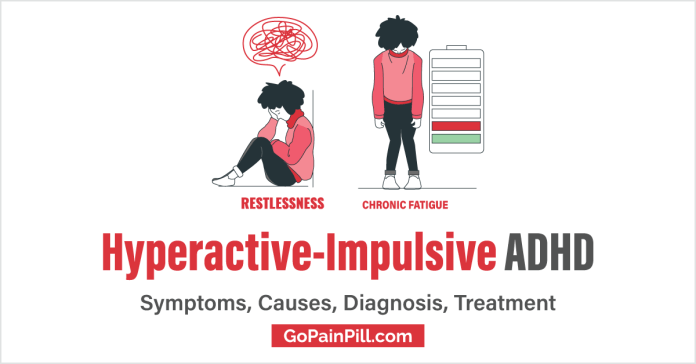Attention Deficit Hyperactivity Disorder (ADHD) is a diverse condition that presents in different forms. One of the subtypes is Hyperactive-Impulsive ADHD, also known as ADHD predominantly hyperactive-impulsive presentation.
This form of ADHD is characterized by excessive levels of activity and impulsivity, setting it apart from other types of the disorder.
In this article, we will delve into Hyperactive-Impulsive ADHD, exploring its symptoms, potential causes, and effective management strategies.
- Learn types of ADHD and the Inattentive types.
What is Hyperactive-Impulsive ADHD?

Hyperactive-Impulsive ADHD is one of the three main subtypes of ADHD, along with inattentive and combined presentation.
Individuals with this form of ADHD exhibit significant hyperactivity and impulsive behavior, often leading to challenges in various aspects of their lives.
- Also read: Inattentive types of ADHD.
Symptoms of Hyperactive-Impulsive ADHD
The symptoms of Hyperactive-Impulsive ADHD are usually quite noticeable and can be observed in different settings. Common signs include:
- Excessive Restlessness: Individuals may appear fidgety or restless, having difficulty remaining seated when expected.
- Impatience: An inability to wait for their turn, whether in conversations or during activities, is a characteristic feature.
- Blurting Out Answers: Impulsivity may lead individuals to blurt out responses or interrupt others before they finish speaking.
- Difficulty Engaging in Quiet Activities: Individuals may find it challenging to engage in activities that require quiet and sustained focus.
- Acting Without Thinking: Making impulsive decisions without considering the consequences can be a significant challenge.
Causes of Hyperactive-Impulsive ADHD
The exact causes of Hyperactive-Impulsive ADHD, like other forms of the disorder, are not entirely clear. However, several factors may contribute to its development:
- Genetic Predisposition: Family history of ADHD plays a role in the likelihood of developing the disorder. Individuals with close relatives diagnosed with ADHD may have an increased risk of Hyperactive-Impulsive ADHD.
- Neurobiological Factors: Differences in brain structure and function, particularly in regions responsible for impulse control and attention, may contribute to Hyperactive-Impulsive ADHD.
- Chemical Imbalance: Neurotransmitters like dopamine and norepinephrine are involved in regulating attention and impulse control. Any imbalance in these neurotransmitters may influence the development of ADHD symptoms.
Diagnosing Hyperactive-Impulsive ADHD
Diagnosing Hyperactive-Impulsive ADHD requires a thorough evaluation by a qualified healthcare professional. This typically involves:
- Clinical Assessment: A detailed clinical assessment is essential to gather information about the individual’s medical history and any existing medical conditions.
- Behavioral Analysis: Observations of the individual’s behavior in different settings, such as at home and school, can provide valuable insight into their symptoms.
- Rating Scales and Questionnaires: Standardized rating scales and questionnaires are often used to assess the severity of ADHD symptoms and their impact on daily life.
- Exclusion of Other Conditions: It is crucial to rule out other medical or psychological conditions that may present similar symptoms to Hyperactive-Impulsive ADHD.
Management and Treatment
Effective management of Hyperactive-Impulsive ADHD involves a comprehensive approach, considering the individual’s specific needs. Some essential components of management include:
- Behavioral Therapy: Behavioral therapy, such as Cognitive Behavioral Therapy (CBT), can help individuals develop coping skills and strategies to manage impulsivity and hyperactivity.
- Medication: Medications, particularly stimulants like adderall, may be prescribed to help reduce hyperactivity and improve attention.
- Educational Support: Collaborating with educators to implement classroom accommodations can better support individuals with Hyperactive-Impulsive ADHD.
- Parent and Teacher Involvement: Parents and teachers play pivotal roles in supporting individuals with ADHD. Consistent communication and collaboration can enhance the management process.
Lifestyle Tips for Individuals with Hyperactive-Impulsive ADHD
Beyond formal treatment, lifestyle adjustments can significantly improve the overall well-being of individuals with Hyperactive-Impulsive ADHD:
- Physical Activity: Engaging in regular physical activity can help channel excess energy and reduce hyperactivity.
- Structured Routines: Establishing structured daily routines can provide a sense of predictability and stability for individuals with ADHD.
- Time Management Techniques: Implementing time management techniques, such as using timers or visual schedules, can aid in organizing tasks and activities.
FAQs
1. Can Hyperactive-Impulsive ADHD be outgrown?
ADHD is a chronic condition, but symptoms can change over time. Some individuals may experience a reduction in symptoms as they learn coping strategies and mature. However, others may continue to experience symptoms into adulthood.
2. Is Hyperactive-Impulsive ADHD more common in boys or girls?
Hyperactive-Impulsive ADHD is more commonly diagnosed in boys than girls. However, it can affect individuals of any gender.
3. Can medication completely cure Hyperactive-Impulsive ADHD?
Medication can help manage the symptoms of Hyperactive-Impulsive ADHD, but it is not a cure. It is usually used as part of a comprehensive treatment plan that may include behavioral therapy and lifestyle adjustments.
4. Is Hyperactive-Impulsive ADHD a lifelong condition?
ADHD is a chronic condition, and for many individuals, it can persist into adulthood. However, the severity of symptoms and their impact on daily life may vary over time.
5. Can adults have Hyperactive-Impulsive ADHD even if they didn’t have it as children?
Yes, some individuals may not be diagnosed with ADHD until adulthood, even if they did not display obvious symptoms during childhood. Adult-onset ADHD is recognized by healthcare professionals and can be managed effectively with appropriate interventions.
Conclusion
Hyperactive-Impulsive ADHD, also known as ADHD predominantly hyperactive-impulsive presentation, is a distinct form of ADHD characterized by excessive activity and impulsivity. Early recognition and intervention are essential in providing effective support to individuals with this subtype.
A combination of behavioral therapy, educational accommodations, and, when appropriate, medication can significantly enhance their ability to manage symptoms and thrive in various aspects of life.
